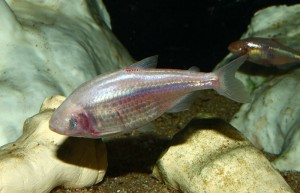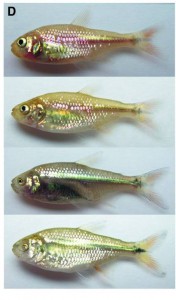Imagine a fish that can lose its eyes depending on the environment in which is it born.
Astyanax mexicanus, reared in the limestone caves of Northeast Mexico, exhibits eyes degeneration, small eye sockets, and albinism. However, this phenomenon is not due to long term evolution; a paper by Rohner and colleagues suggests it is due to cryptic, or “hidden,” gene variation which becomes expressed under stress. The protein which may be mediating this expression is known as heat shock protein 90 (HSP90).
HSP90, which aids in the proper folding of proteins, is linked to proper eye development and is extremely sensitive to stress. Therefore, Rohner and colleagues hypothesized that the cave environment may produce a stress response which inhibits HSP90, resulting in eye degeneration.
To test their claim, Rohner and colleagues needed to prove that 1) inhibiting HSP90 could produce the blind cavefish phenotype and that 2) the cave environment could inhibit HSP90. They found increased variability in eye size of embryos treated with an HSP90 inhibitor. They also found that embryos reared in low conducting water, akin to that of the cave environment, produced this same variation in eye size. Because decreased water conductivity can create a heat shock-like stress response, this provides evidence for the mediating role of HSP90 in eye size variability.
This data suggests that 1-2 million years ago, the low conductivity of the cave water produced a stress response in A. mexicanus inhibiting HSP90 and revealing genetic variability in eye size. Smaller eyes could have then been selected for in the dark cave due to energetic efficiency. Large eyes can be costly to develop and maintain and, therefore, in the absence of light, maladaptive. Thus, A. mexicanus instead evolved to have larger tastebuds and a more sensitive lateral line system to sense changes in water pressure.
In this paper, Rohner and colleagues used A. mexicanus to show how cryptic genetic variations can be revealed by exposing a species to environmental stress. By showing how the blind cavefish phenotype emerged under stress induced inhibition of HSP90, they combined a molecular basis for evolution with an environmental trigger. By showing how the environment can affect gene expression, induce genetic variability, Rohner and colleagues are helping us understand the numerous factors that can play a role in evolution.
Rohner H, Jarosz DF, Kowalko JE, Yoshizawa M, Jeffery WR, Borowsky RL, Lindquist S, and Tabin CJ. (2013). Cryptic variation in morphological evolution: HSP90 as a capacitor for loss of eyes in a cavefish. Science, 342: 1372-1375


